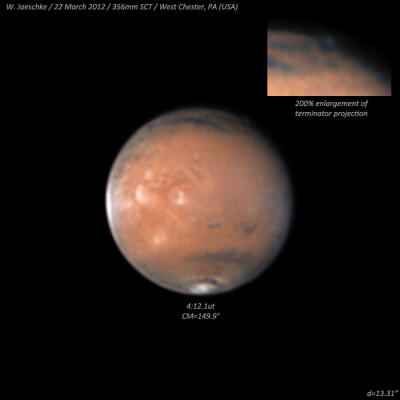|

by Alan Boyle
March 23, 2012
from
CosmiClog.Msnbc Website

Amateur
astrophotographer Wayne Jaeschke captured this image
of a "terminator projection" rising up from the edge
of the Martian disk at about the 1 o'clock position
on March 22. The inset photo is a 200 percent
enlargement of the region around the projection.
For more, check
out
Exosky.net,
Jaeschke's website.
Amateur astronomers are puzzling over a
seemingly anomalous cloud that has shown up on images of Mars taken
over the past few days.
Is it really a cloud, or a trick of the
eye? Does it really extend 150 miles up from the surface, as some of
the observers suggest? And what churned up all that stuff, anyway?
The amateurs and the pros will be trying
to resolve those questions before the phenomenon fades away.
"It's not completely unexpected,"
Jonathon Hill, a member of the team at the Mars Space Flight
Facility at Arizona State University, told me today.
"But it's bigger than we would
expect, and it's definitely something that our atmosphere guys
want to take a look at."
Hill and his colleagues will be looking
at the area where the cloud was spotted using the Thermal Emission
Imaging System, or THEMIS, which is one of the instruments on NASA's
Mars Odyssey orbiter.
"In the command upload we're
preparing to send today, we've included observations that will
hopefully capture some of these recent clouds," Hill wrote in an
email.
"Our THEMIS camera on Mars Odyssey
is capable of acquiring simultaneous visible and thermal
infrared images, so our atmospheric researchers are pretty
excited about the possibility of not only getting a good look at
the cloud structures, but also their temperatures."
THEMIS will be checking out heightened
cloud activity around Mars' shield volcanoes as well as around the
southern site spotted by the amateurs.
Pictures from a camera on NASA's Mars
Reconnaissance Orbiter, called the Mars Color Imager, or MARCI,
might provide further clues about the southern cloud feature. And
amateur astronomers are sending out the alert for observers to keep
a close watch on the Red Planet over the coming days.
There's been lots of buzz about the high-altitude cloud on Cloudy
Nights and other online discussion forums for skywatchers. Sky &
Telescope's Sean Walker says the puff of white was first noticed on
March 20 by Wayne Jaeschke, an amateur astrophotographer from
Pennsylvania. Since then, other observers have identified the
feature in images going back as far as March 12.
All sorts of hypotheses have been proposed: Could it be debris
kicked up by a meteoric impact? Is it a huge weather system? Is it
merely a funny kind of glint caused by a combination of lighting and
atmospheric conditions?
In an email, Jaeschke told me that the feature is,
"still there, although it has
decreased in size over the past two days."
"This has led some to believe that it was some sort of
transient-type event," Jaeschke said.
So it's crucial to make as many
observations of the area as possible over the next few days.
Wayne Jaeschke created this animated GIF image of Mars with the
cloud coming into view on the upper right edge of the planet's disk.
For more from Jaeschke, check out his Exosky website.
Walker says the feature is currently well-placed for viewing from
the Americas. He says it should show up on the edge of Mars' disk
around 1:10 a.m. ET Saturday, and 39.5 minutes later on each
succeeding night. Consult the photos above for guidance on where to
point a medium-size telescope - keeping in mind that these images
are inverted to appear as they would through a telescope, with south
pointing "up."
Arizona State University's Hill says the
area in question is called Terra Cimmeria.
Observation reports should be sent via email to Richard McKim,
director of the British Astronomical Association's Mars Section.
(The linked website includes McKim's email address, as well as a
picture of the chap.)
Solving this mystery - if it indeed turns out to be an
honest-to-goodness mystery rather than a mere quirk - may require
additional data from the big guns of the astronomy world.
But in any case, the episode illustrates
once again how much amateurs can contribute to uncovering the
wonders of the cosmos.
"When it comes to Mars, amateurs and
professionals working together give you way more insight into
ongoing processes, because with so many amateurs, you're
continuously monitoring changes in the planet," Hill told me.
"They provide a perspective and a
context that we don't usually get."
|

